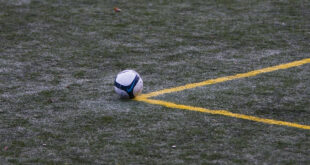May, 2007. Politics have become so divisive in Lebanon, on the streets and
Opposition media gave Hariri's memorial demo minimal coverage.
on TV screens, that the national media council chief urged the media in January to curb "tense rhetoric" that could instigate violence among the country's religious sects.[1]
Lebanon was plunged into a power struggle on December 1, 2006 when the Hizbullah-led opposition, consisting of Shiite Muslim parties and Michel Aoun's majority Christian party, camped out in downtown Beirut to call for the overthrow of Prime Minister Fouad Siniora's pro-US government.[2]
The situation reached a climax in January following two separate clashes between pro- and anti-government supporters that left seven dead and 190 wounded.
Purchases of automatic weapons have also reportedly risen, from $100 to $1000 for an AK47, and with the government seizing a cache of arms intended for Hizbullah in March, concerns were raised that the sectarianism of Lebanon's 15-year civil war, which ended in 1990, could return.
The Lebanese media has played its role in the current crisis, with the National Media Council president, Abdel-Hadi Mahfouz, blaming the media for stoking sectarianism and engaging in political insults.
"Media institutions are strongly asked to ease tensions and avoid transmitting news that might lead to strife," said Mahfouz.
Although the situation has calmed down in the past two months, the opposition is still occupying much of downtown, political discussions are at an impasse, and the divisions still hold, fuelled by the country’s sectarian media.
The two camps
Lebanese TV channels are split into two camps: on the one hand, Hizbullah-backed Al Manar TV, the National Broadcasting Network (NBN) and New TV pro-opposition, and on the other hand, Mustaqbal (Future) TV and the Lebanese Broadcasting Company (LBC) pro-government.[3]
"Every Lebanese TV channel has a propaganda leaning. Some try to be balanced, but all have their agendas. It's pretty clear from the content they produce," said Habib Battah, Managing Editor of the Beirut-based Middle East Broadcasters Journal.
Lebanon's media has long reflected the country's political and religious divisions, but sectarianism has arguably become more pronounced following the war between the militant Shiite group Hizbullah and Israel last year.
"The interesting thing is during the July war the same footage was used on many channels, supporting Hizbullah. So sectarianism has gotten more divisive, more apparent," said Battah.
Nabil Dajani, a communications professor at the American University of Beirut, said the media were deliberately inflaming sectarianism, but believed the blame does not lie solely with the media.
"You can't only blame the media – who is behind the media? Politicians. And it's the government's fault for allowing the media to get away with it. There is an audiovisual law that prohibits sectarianism, but this government is delinquent and doesn't step in," he said.
A further example of the government’s Janus face revolved around the arrests of New TV journalists Firas Hatoum and Abdel-Azim Khayat on December 19 for entering the Beirut apartment of Mohammed Zouheir Siddik. A leading prosecution witness in the assassination of former Prime Minister Rafik Hariri, Siddik was away in France at the time.
In what is widely viewed as a politically motivated action to warn off journalists from delving further into the highly contentious and politically charged UN investigation into Hariri’s death, the journalists were charged with “theft” for entering the apartment and moving evidence that was “important for the investigation.”[4]
Although the journalists allegedly had Siddik’s permission to enter his apartment and remove certain documents, the journalists were not prosecuted under press law (as Lebanese law requires) but rather with theft under criminal law. After six weeks of appeal the journalists and their driver were released on bail from Lebanon’s notorious Roumie prison. They face between three to eight years in prison.[5]
Propaganda clips
Sectarianism and the trading of political insults are most apparent in news coverage and on talk shows.
"An important anti-government event or speech will be covered by one set of media but not by pro-government channels," said Battah.
An example is the demonstration on February 14 attended by tens of thousands of Lebanese to mark the second anniversary of the assassination of Hariri.
Opposition channels gave sparing coverage of the event, while pro-government channels LBC and Future TV gave extensive live coverage and were visibly present in Martyrs’ Square.[6]
"The media will also use clips taking (political) speeches out of context," added Battah.
The TV channels many observers regard as particularly sectarian are Future TV, owned by Saad Hariri, a Sunni member of parliament and the son of Rafik Hariri, and Hizbullah's Al Manar TV.
"There is intense rivalry between Future and Al Manar, from guests on talk shows to promo propaganda clips," said Battah.
.jpg)
In Lebanon, political protests attract people of all ages.
Indeed, by watching either of the channels one can quickly ascertain the channel’s political allegiance. On Al Manar new promo clips are aired almost weekly, ranging from montages hailing ‘martyrs’ from the July War with Israel to highlights of Hizbullah’s military capabilities, to music videos that depict Southern Lebanon, support for the Lebanese army, commemorating the dead, and Hizbullah’s leader Hassan Nasrallah. Al Manar’s selection of news also reflects its political orientation and viewership, giving extra attention to issues in Southern Lebanon and the Bekaa (predominantly Shia areas), Palestine, Syria and Iran.
On Future TV, montages praising Rafik Hariri’s legacy are regularly shown along with promos promoting the March 14th movement. In terms of news Future focuses on Lebanese issues, albeit with less focus on the South, and gives more airspace to Sunni issues and political backers such as Saudi Arabia.
Nothing could be quite as blatant about the channel’s allegiance—other than the name which reflects its links to Saad Hariri’s Sunni party Tayyar Al Mustaqbal (Current for the Future)—as the façade of Future’s headquarters on Spears Street in Beirut. The walls surrounding the building are covered with banners of Rafik Hariri, images from Hariri’s assassination on February 14, 2005, and of the massive March 14 demonstration in Martyrs’ Square in the same year that eventually led to the withdrawal of Syrian troops from Lebanon.[7]
Nadim Munla, Chairman and General Manager of Future TV, bristled at the idea that the channel is fuelling sectarianism in Lebanon.[8]
“I totally disagree with this. You can go back to the history of the channel and we have been leaders of issues that relate to the future of Lebanon, such as Israeli atrocities. We do reflect the situation in Lebanon and if you don’t, you are biased. All of Hassan Nasrallah’s speeches are live on Future, and we have a daily show that sums up all the news channels in Lebanon,” he said.
Asked about the Media Council’s statements, Munla went on the offensive.
“Lebanon is not going through normal times so to assume or imply international criteria on Lebanese media during abnormal times is unfair,” he said.
Munla thinks the media council is “hypocritical” to call on TV channels to curb sectarianism, saying the council needs to start with themselves before pointing the finger at others, given that some members are involved in the local newspaper market.
“They are political appointees. It is not impartial so I don’t want a lecture on how to do business,” he said.
Nonetheless, Munla stated that the media should be at the forefront of change in Lebanon.
“I think Lebanon is fighting for its independence, and the media cannot just be an observer of these developments. It should be the spearhead for change and we are proud that we are playing this role,” he said.
Indeed, some video montages on TV are aimed at discouraging sectarianism and violence.
One montage on Al Manar showed a clock ticking back from 2007 to 1975, the year the civil war started. Attached to the clock were images from the January clashes as well as archive footage, ending with "Let's not go back" in Arabic.
On the pro-government channels a series of adverts saying "I Love Life," part of a massive nationwide ad campaign, have been aired.
Tensions are not expected to ease any time soon though, with Future TV to launch a 24-hour news channel and Michel Aoun's party to launch Orange TV (OTV) later this year.
To the Future
Future TV expects to launch its new channel in the next month, “unless there are more unseen events,” said Munla.
The new channel is part of a major restructuring at Future, with new content on the entertainment channel and sales directed more at the Gulf region.
“The last pillar of change was to introduce a 24-hour news channel, the main reason being that in the last two years we allocated more time to cover the news and current affairs,” said Munla.
He said the channel had regularly violated the time allocated to news, earmarked at 20% of broadcast time, due to Lebanon’s turbulent politics.
“That affected our viewing base, and adversely affected our entertainment channel, so we will have a 24-hour news channel,” he added.
The new $10 million channel is considered a financial necessity as a result of the July war, with the conflict and the aftermath costing Future over 25% of its projected advertising revenue for 2006. By launching the new channel with a state of the art 1800-meter studio, Future TV intends to claw back its profit and regional position among the top five. Munla said that by the end of the year Future hopes to return to “pre-recent event levels” and by 2008 recover its market share.
News will be primarily Lebanese, but will also allocate 20% of content to European-Arab affairs to boost interactivity and understanding between the two regions.
Meanwhile, OTV, a brainchild of Michel Aoun’s, is raising funds through a joint stock company open to the public. Starting with a paid up capital of $2 million, OTV has raised over $10 million via one million $10 shares to establish a terrestrial and satellite channel, and is currently embarked on a regional road show to whip up demand for the remaining shares.
To Lebanon observers the colourful name of the channel will immediately be associated with a political party—Aoun’s Free Patriot Movement (FPM). And true to form, Aoun came up with the idea of a channel “For the People, By the People” through collective ownership.
So will the channel be yet another addition to Lebanon’s highly politicized media landscape where every channel, radio and newspaper has a political connection of some form or another?
Roy Hachem, the CEO of OTV, said it will not be another party mouthpiece. “Aoun won’t influence the channel, and it will be independent of the party. I know it’s hard to prove, we need to start transmission and broadcast news,” he said.
What about the colour though? “People may ask about the colour, as orange, but it’s the only [political] link we have and a colour the publicists wanted,” Hachem said.
Media observers are not as convinced however. “I think the station is portraying a very specific political point, which is clear from the colour and symbolism. I think it will follow a pattern, of a political constituency for a station. There is no reason to believe it will be different as when you open the first page of their brochure there is a photo of Aoun. But it’s hard to say, it could surprise us and be critical of Aoun,” said Battah.
Hachem said OTV will be independent and objective in its delivery of news. “We want something like the BBC. I want to hear people saying—even if not good for the FPM—I heard it on OTV.”
Hachem also pointed to the different categories of shareholders as a further example of how the channel is not being solely supported by FPM followers.
“Some are looking for a dream, others are serious investors. We have people buying $300,000 to $500,000 of shares,” he said. Supporters on the other hand tend to buy between 100 to 300 shares.
Not all bad news
The divergence of opinion on Lebanon’s TV screens can be seen to be fanning the fires of sectarianism and political differences, but on a pragmatic level such a kaleidoscope of opinions can be seen as a rather healthy, democratic media environment.
“If freedom of expression is measured in how often the opposition is on pro-government stations and vice-versa we can be considered a highly democratic media industry,” said Munla.
Most countries have only a couple of TV news channels, one often government run or leaning, and a few commercial outlets. Lebanon on the other hand is, like in so many other regards, an apparent exception to this rule with only Iraq’s burgeoning TV market, equally beset by sectarianism and numerous political backers with an organ to grind, comparable in any way.[9]
“It’s not black and white in Lebanon, you see peoples real feelings about each other whereas in the US all news channels resemble each other after a while. The order might be different, but the stories are the same,” said Battah. “The US can seem like a monolith,” he added.
In Lebanon however there are more channels critical of the government than pro, although in terms of viewing figures LBC and Future have the lion’s share.
This disparity could change if pro-government Murr TV (MTV), which was kicked off the air by the government in 2002 for criticising Syria, returns to Lebanese screens. Until then, Future TV’s new addition may make some inroads for the March 14 movement when it launches, but quantitatively the opposition will still have the upper hand in the TV media battle until some solution to the current crisis is found in the quagmire that is Lebanese politics.
Paul Cochrane is a contributing editor for Arab Media & Society and a freelance journalist based in Beirut, writing on politics, media, business and education. He has reported for The Independent On Sunday, The Frankfurter Allegemeine Zeitung, The Straits Times, Jane's, and The Times Higher Educational Supplement. Cochrane formerly worked as an editor at Beirut's The Daily Star and was news editor of Middle East Broadcasters Journal. He holds a MA in Middle Eastern Studies from the American University of Beirut and a BA in International Politics and International History from Keele University, England.
All photographs by Paul Cochrane.
 Arab Media & Society The Arab Media Hub
Arab Media & Society The Arab Media Hub





